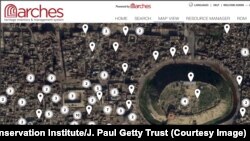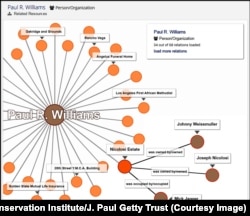Damage to mosques, a monastery, churches and historic tombs caused by fighting near the Syrian city of Aleppo, and the destruction of monuments by the so-called Islamic State in the ancient cities of Palmyra and Nimrud, are being documented in an online archival system and made available to conservation experts worldwide.
The crowd-sharing system called Arches uses satellite imagery, photographs, technical data and eyewitness descriptions.
“It's online, it's freely available, it's open source,” said Tim Whalen, director of the Getty Conservation Institute, which developed the software with the New York-based World Monuments Fund.
The system is being used by the American Schools of Oriental Research to monitor historic sites in Syria and northern Iraq, providing weekly updates and an online inventory of thousands of heritage sites.
The American Schools' Cultural Heritage Initiatives, which receives support from the U.S. State Department, has documented damage or destruction at hundreds of sites, and is developing protocols for post-war preservation.
Extensive damage to world heritage
Satellite images have shown demolition of the ancient Temple of Baalshamin in Palmyra, an ancient trading center and UNESCO World Heritage Site northeast of Damascus. UNESCO Director-General Irina Bokova called the loss a “war crime.”
Islamic State militants have destroyed religious monuments that the group considers un-Islamic, and among those killed in the occupied regions was a Syrian archeologist who had been caring for the site for 40 years. IS has also looted and sold antiquities to finance its operations.
The militants held Palmyra for 10 months before Syrian government forces retook the region in March, with help from Russian airstrikes. Journalists who toured the site say that some important structures escaped destruction.
Heritage groups were alarmed, however, when the Russian military built what it called a temporary base within the World Heritage Site boundaries. A weekly report from the American Schools says that the Russian military presence, which was expanding through early June, has recently decreased.
Widespread applications
The online system Arches has other applications outside the Middle East. It has been used create an inventory of Bronze Age sites in central Europe as part of the effort of “protecting knowledge for the future,” said the Getty's Tim Whalen.
The Los Angeles city planning department is also using the online system to compile a record of sites of cultural interest, locations linked to modernist architecture, the entertainment industry and the city's heritage before 1900. The information can be accessed on a smart phone to unlock the city's “rich cultural history,” said Mayor Eric Garcetti as the project was unveiled early last year.
Conservation involves both preservation of historic sites and artifacts and protection of knowledge, said Whalen, and the online tool is available for free to cultural agencies to help with the effort. The application was recently used to create an inventory of cultural sites in the Philippines, unknown to the system's developers, who say they are pleased to see its expanding applications. They say it can help heritage agencies worldwide, which have important mandates but often little funding.
They say for threatened Mideastern sites, the web-based archive will be a crucial tool for reconstruction in the future. It is one of a number of digital initiatives being used to document and preserve the region’s heritage undertaken by universities, non-profit organizations and governments.
It’s an investment in the “civil society,” said the Getty’s Whalen, which will be crucial to the rebuilding effort.










